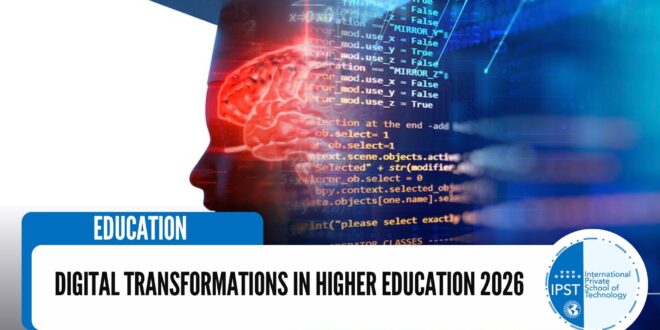In the past decade, higher education has seen a massive shift in how academic programs are delivered, driven by digital advancements that have not only transformed teaching methods but also the content of educational programs themselves. By 2026, universities are expected to undergo a significant transformation in how they design and deliver curricula, incorporating modern technologies such as artificial intelligence (AI), augmented reality (AR), virtual reality (VR), and online learning platforms more integrally. In this article, we will explore how universities will reshape their academic programs to keep pace with the rapid digital transformations.
1. Universities and Digital Transformation: The Beginning of the Shift
Universities have already started incorporating digital technologies to enhance access to education and interact with students. Since 2020, there has been an accelerated shift toward online education, with universities making significant strides in offering online programs and adopting remote learning technologies. Regarding academic curricula, universities have begun transforming traditional programs into flexible formats that leverage digital technologies to meet the changing needs of students.
Source: Times Higher Education – The Digital Revolution in Higher Education
2. Artificial Intelligence: Personalizing Education and Supporting Students
In the near future, AI is expected to become a fundamental part of university curricula. Universities will be able to use AI technologies to personalize educational content based on each student’s needs. By analyzing data such as students’ study patterns and test results, AI will be able to deliver customized content that helps students learn at their own pace and comprehension level. This ability to personalize education can yield better results and significantly enhance the learning experience.
Source: Forbes – How Artificial Intelligence is Revolutionizing Higher Education
3. Virtual and Augmented Reality: Immersive Learning Experiences
Virtual reality (VR) and augmented reality (AR) are expected to become integral parts of academic curricula by 2026. Instead of relying solely on traditional classrooms, universities will be able to offer immersive learning experiences that allow students to engage in interactive educational environments. For example, in the field of medicine, students may perform virtual surgeries in a simulated environment, enabling them to learn without putting patients at risk. Such education can foster deep understanding and better prepare students for real-life situations.
Source: EdTech Magazine – How Virtual and Augmented Reality are Shaping the Future of Education
4. Blended Learning: Merging Traditional Education with Technology
By 2026, most universities are likely to adopt blended learning, which combines traditional in-person classes with online learning. This approach will allow students to interact with instructors and peers in a conventional classroom setting while also giving them access to digital resources that support independent learning. This diversity in teaching methods will enable universities to meet the needs of students who prefer various learning styles.
Source: Inside Higher Ed – Blended Learning in Higher Education: The Future of Education
5. Shifts in Student Assessment: From Traditional Exams to Continuous Evaluation
One of the major transformations universities will experience by 2026 is the shift toward continuous evaluation using digital technologies. This will involve providing instant and personalized feedback through AI tools, helping students improve their performance over time. Instead of relying on traditional exams, universities will use digital tools to track student progress and assess their knowledge and skills in real-time.
Source: The Chronicle of Higher Education – Digital Assessments in Higher Education
6. Leveraging Big Data: Improving Academic and Administrative Decisions
Big data will play a crucial role in enhancing academic programs at universities by 2026. By collecting and analyzing data about student interactions with digital content, universities will be able to make more precise academic decisions. This will enable real-time adjustments to curricula based on student needs and will help improve academic and administrative strategies overall.
Source: EdTech Magazine – Big Data: How It’s Reshaping Higher Education
7. Challenges and Opportunities in Digital Transformations
Despite the expected positive transformations, universities will face several challenges in integrating these technologies into their curricula. One of the main challenges is the need to train both academics and students to effectively use digital tools. Additionally, technical infrastructure and high costs may be obstacles for some institutions. However, the opportunities presented by these transformations can significantly improve access to education and increase learning opportunities.
Source: Inside Higher Ed – Challenges and Opportunities in the Digital Transformation of Higher Education
Conclusion
By 2026, universities will undergo a major shift in how they deliver academic programs thanks to the rapid digital transformations. Educational institutions will be able to use AI, VR, AR, and other digital learning tools to provide more personalized and effective learning experiences. Despite the challenges universities may face in adopting these technologies, the future holds immense potential to enhance higher education and deliver better outcomes for students.
This article provides an outlook on the digital transformations in higher education, highlighting the challenges and opportunities associated with these shifts, supported by reliable sources.
 International Private School of Technology المدرسة الدولية الخاصة للتكنولوجيا Private School مدرسة خاصة للتكوين المهني
International Private School of Technology المدرسة الدولية الخاصة للتكنولوجيا Private School مدرسة خاصة للتكوين المهني


